AMD Launches Mobile Kaveri APUs
by Jarred Walton on June 4, 2014 12:01 AM ESTAMD Kaveri FX-7600P System/CPU Performance Preview
After the briefing, we were given a chance to benchmark a prototype Kaveri notebook for a few hours. That wasn't enough to run our full suite of laptop benchmarks, and battery testing in particular is something we couldn't perform. I did run some quick simulations of battery life; however, the prototype systems are optimized more for performance rather than power, so the results weren't really meaningful. We'll have to wait for retail laptops with Kaveri APUs before we can really see what sort of battery life to expect, but AMD claims there should be a decent jump in mobility compared to Richland.
The test systems were more of a proof of concept rather than anything you could actually sell. The keyboard was okay if a little mushy, but the touchpad in particular I found a bit lacking, and build quality was mediocre as well. The screens at least were good quality 1080p 15.6" touchscreen panels, and that was enough to get us benchmarking. I snapped a few pictures of the laptop that you can see above. In terms of other core specs, the laptop had 8GB of DDR3-1866 RAM and a Samsung M.2 256GB SSD.
For our purposes here, we're including the AMD Kaveri Prototype, AMD Trinity Prototype, and AMD Kabini Prototype laptops as a starting point. For retail laptops, we have the MSI GX60 with Richland A10-5750M APU (but only a single 8GB SO-DIMM, unfortunately), the Sony VAIO Pro 13 (i5-4200U), and the Acer V7-482PG (i7-4500U + GT 750M). The Acer is the only laptop equipped with a discrete GPU, so we wanted to see how Kaveri stacks up against such a system. You can compare additional results against Kaveri in Mobile Bench, of course.
Again, these numbers are only preliminary – the drivers for the GPU were slightly older (without Mantle support enabled yet), and there were occasions of odd behavior where other editors had scores that didn't match up with our results until after a reboot. We were not able to run each benchmark multiple times, so most of these results are from a single run. AMD is keen to talk about the GPU improvements with Kaveri, but I also wanted to see what has happened on the CPU side, so we'll start with our CPU/system benchmarks.
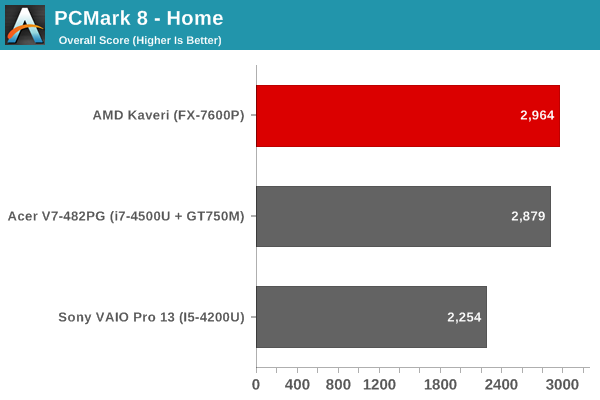
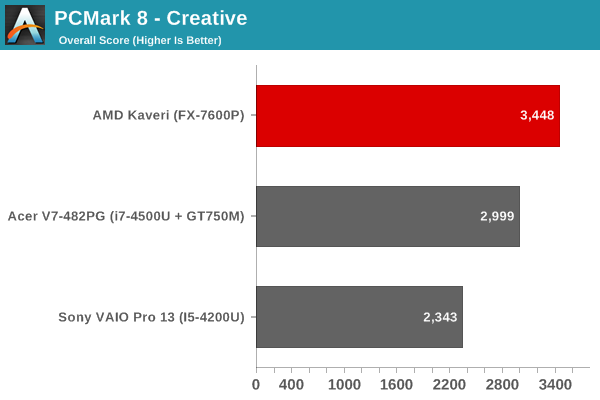

We don't have results for PCMark 8 for many of the systems, and the VAIO Pro 13 seems to be underperforming for some reason, but otherwise we get a pretty good idea of where things fall in terms of overall performance. Note that PCMark 8 is now OpenCL accelerated, which can improve performance quite a bit on AMD APUs. The result is that AMD actually takes the lead in the Home and Creative suites, but without more time benchmarking the system I wouldn't try to draw too many conclusions. Storage subsystem performance can still have an enormous impact on PCMark results, and the V7-482PG has to get by with an SSD caching solution. The VAIO Pro 13 on the other hand just seems to score a bit lower than I'd expect, so again take these scores with a grain of salt.
Moving on to other benchmarks, I also ran PCMark 7 as it doesn't have any OpenCL acceleration and will provide a better view of traditional application performance. Hopefully we'll continue to see improvements in the use of OpenCL (GPU) acceleration and over time PCMark 8 scores will be more indicative of real-world performance, but right now there are plenty of situations where having a GPU does very little for performance.

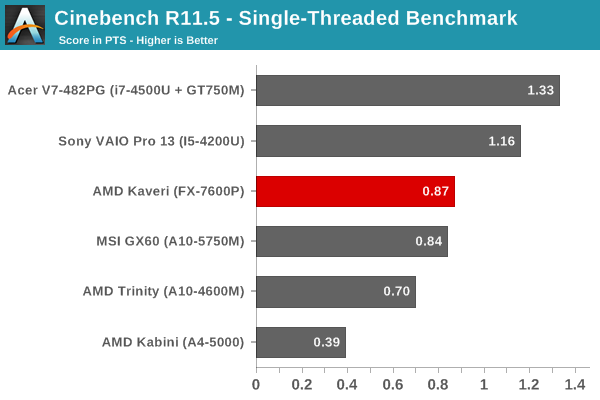
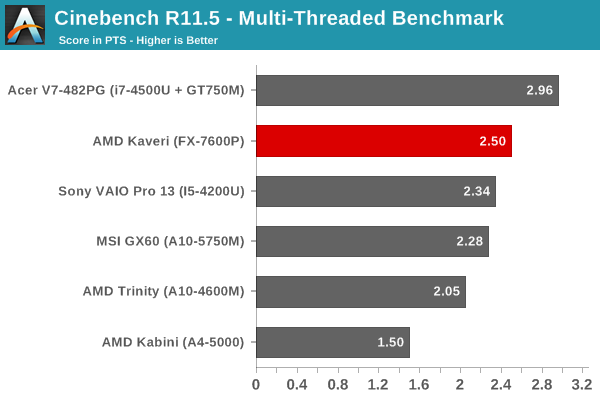
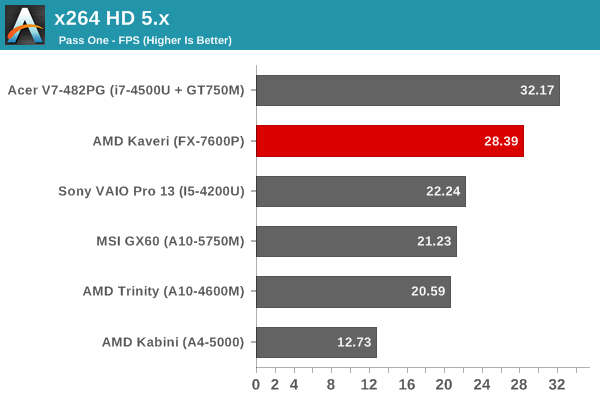
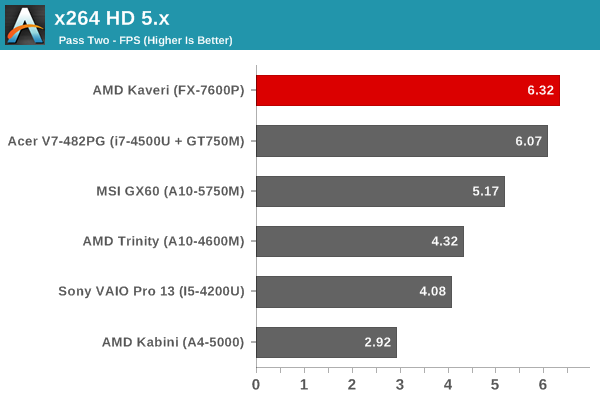
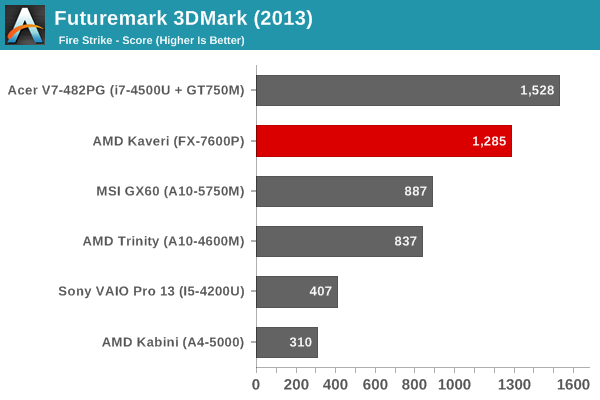
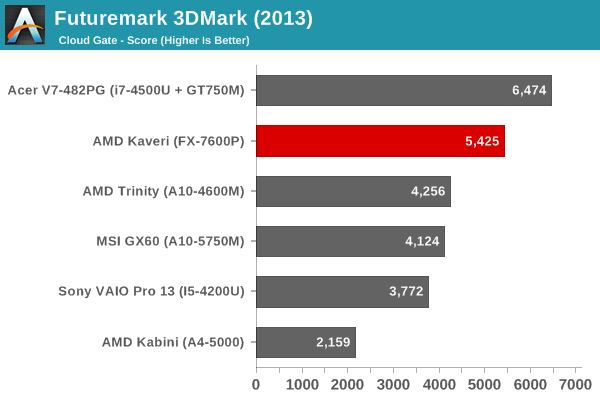

Somewhat surprisingly, Kaveri actually takes the lead in the very demanding second pass of the x264 HD 5.0 encoding test. Granted, we're looking at a 35W APU vs. 15W ULV CPU, and Intel's 37W quad-core parts would certainly retake the lead (and cost quite a bit more), but at least Kaveri is showing some real improvements over Richland in these tests. As noted above, PCMark 7 doesn't have any OpenCL optimizations so the gap between AMD and Intel is a bit wider.
Moving to the 3DMark results, Kaveri shows an impressive increase in performance over the Trinity/Richland GPU, which is expected. Intel's iGPU – particularly in the ULV system shown here – just doesn't stand a chance. While we are potentially TDP limited for the ULV Intel parts in graphics tests, my experience is that 3DMark hits the GPU much more than the CPU, so the GPU gets the lion's share of the TDP. I'll try to run some tests on other Haswell systems using the iGPU to verify the above results, but outside of the HD 5000 and Iris parts, I wouldn't expect Intel's iGPU to be too much faster than what we're seeing here.
Overall, an Intel CPU with a discrete GPU is still faster than Kaveri in most areas, and a quad-core i7-4702QM would really distance itself from AMD's Kaveri…but the quad-core i7 CPUs tend to start at around $350, so there's not much point in discussing that comparison. My personal feeling is that unless you're really pushing a laptop hard, most of the modern CPUs/APUs are plenty fast. I wouldn't want a Kabini APU, but Trinity/Richland, Ivy Bridge, Kaveri, and Haswell are all going to be fine for everyday use.
The more important element for me with a laptop (or desktop) is that I simply can't stand using conventional hard drives for the primary storage device any longer. Given the choice between an AMD Kaveri APU with a 256GB SSD (the Crucial MX100 is sure looking nice!) and pretty much any other laptop that has pure HDD storage, it's a no brainer for me. In fact, laptop manufacturers would do their customers a great service if they took the cost savings of AMD's APU vs. Intel's CPU and put that into a decent SSD solution rather than chasing the lowest possible price!


_thumb.jpg)
_thumb.jpg)
_thumb.jpg)
_thumb.jpg)
_thumb.jpg)








125 Comments
View All Comments
rhx123 - Wednesday, June 4, 2014 - link
I am really confused about the Acer, as according to Ark, the 4500U has no PCIE 16x lane output, how is the 750M attached?http://ark.intel.com/products/75460/Intel-Core-i7-...
TheinsanegamerN - Wednesday, June 4, 2014 - link
It has a single x4 link and dual x2 ink. the 750m would be connected by the x4 link.coburn_c - Wednesday, June 4, 2014 - link
The GPU isn't good enough to game with and the CPU isn't good enough to do anything else with. You'll get half the battery life of the competition and it will get twice as hot. Abject failure.frozentundra123456 - Wednesday, June 4, 2014 - link
Yes, you hit on the crux of the matter. Problem is still that of all APUs, the igp performance is still in limbo: almost there but not quite for gaming, while cpu performance and power consumption trail intel badly. Looking at the gaming tests, looks like one will be limited to 768p, and even then COH (admittedly terribly optimized) is not playable, and we have no tests for demanding games like Watchdogs, Metro LL, or Crysis 3. So one will be stuck with either a crappy 768p screen or playing at non-native resolution for a lot of games. Not to mention, this mobile chip should have come out first instead of being so close to the broadwell mobile launch.silverblue - Wednesday, June 4, 2014 - link
You say "cpu performance and power consumption trail intel badly". There's no real data on the latter apart from TDP values (which, in themselves, aren't an accurate indicator), and the FX-7600P is certainly no slouch when viewing the CPU benchmarks in this preview. Let's not forget that large portion of the die dedicated to the GPU, either - just because it's there, doesn't mean it's being used. Toms had the FX-7600P doing well at GPGPU (it should) and PCMark, less well at physics scores in 3DMark (the competition was a high-end i7) and even worse in Sandra, but we know that doesn't always mean everything; after all, the Core 2 had low memory bandwidth due to having no IMC but was still easily the match of the Phenom II series.This is a preview, so quite why people are expecting numerous tests on 2013/14 titles from a very brief testing period is beyond me. Patience, grasshopper!
Novaguy - Thursday, June 5, 2014 - link
But I suspect you can hit 1080p with an awful lot of 2007~2012 games, making kaveri mobile + 1080p a great humble bundle mobile gaming solution. Now, if they combined it with freesync, you could get away with lower frame rates and play even more recent games.The_Assimilator - Thursday, June 5, 2014 - link
The use case for a laptop is simple: you don't require graphics horsepower the majority of the time. Hence it makes more sense to use a CPU that uses less power (and performs better), and pair it with a discrete GPU that won't be drawing any power most of the time. Intel understands this and it's why they make money.AMD on the other hand, have dreamed up a mythical future reality where everyone who buys a laptop expects it to deliver decent GPU performance. But very few people buy laptops to play games on, they buy laptops to be productive while mobile - and faster CPU that use less battery power are always going to win out.
nemi2 - Wednesday, June 4, 2014 - link
It's becoming more of a glaring omission as time progresses that AMD doesn't have a SSD caching option in their SATA BIOS/drivers. AMD is targeting the cheaper end of notebooks so I agree with the author: a pure SSD storage solution will not make the BOM, and because there is no AMD SSD caching solution a 8,16,32GD SSD cache can't make the BOM either - discrete chece is not supported and a hybrid HD unfortunately also seem to also command a $ premium and don't have as good integration with windows.Makes me wonder what the state of USB "ready boost" is with Windows these days?, things are very quiet on the that front. Also where is a cheap / free 3rd party utility to provide SSD/ NVM caching, do AMD laptop vendors have any budget / driver solution?
lmcd - Wednesday, June 4, 2014 - link
The SSD caching probably explains it -- thanks for posting (not an obvious conclusion to reach!)JarredWalton - Wednesday, June 4, 2014 - link
SSD caches are really only good for two things:1) Inflate certain benchmark scores (PCMark being a major one).
2) Help laptop boot/resume faster.
Seriously, most other tasks that hit the storage hard -- installing an application, loading a bunch of apps at once, opening a browser with 30 active tabs -- are all only slightly faster than an HDD with SSD caching, where a pure SSD is substantially faster. The best SSD caching solution right now comes from Apple, and it's only good because it's 64GB or more; 24/32GB SSD caches just don't cut it in my experience.